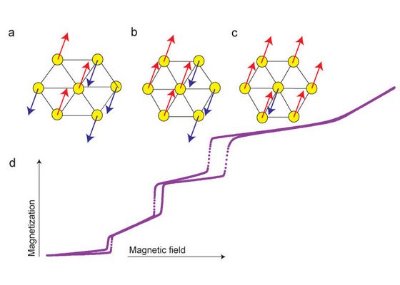Jan. 19, 2007 Research Highlight Physics / Astronomy
The staircase to magnetic order
Researchers record the first direct observation of the correlation between magnetic order and crystal structure in strong magnetic fields
 Figure 1: The relationship between magnetic order and the crystal structure of CuFeO2. With an increasing magnetic field, the magnetic moments (blue and red arrows) align (a-c), leading to steps in the magnetization (d). Simultaneously, the hexagonal lattice becomes more symmetric.
Figure 1: The relationship between magnetic order and the crystal structure of CuFeO2. With an increasing magnetic field, the magnetic moments (blue and red arrows) align (a-c), leading to steps in the magnetization (d). Simultaneously, the hexagonal lattice becomes more symmetric.
Condensed-matter physicists have a strong interest in transition metal oxides, ceramics based on elements from groups 3 to 11 of the periodic table such as manganese or copper. Many unusual magnetic phenomena are observed in transition metal oxides, as their crystal structure often leads to a complicated arrangement of the atomic magnets. One example is the compound CuFeO2 in which the magnetic iron atoms arrange themselves in a hexagonal lattice that is slightly distorted due to an effect known as magnetic frustration (Fig. 1a). At low temperatures, CuFeO2 shows an antiferromagnetic order, where some of the iron magnets point upwards, others downwards.
A team of researchers from the RIKEN SPring-8 Center in Harima and from the universities of Tokyo and Osaka have now unraveled the complex interplay between this magnetic arrangement and the hexagonal structure of CuFeO2. In experiments published in the journal Physical Review B 1, the team used a newly designed magnet capable of reaching very high magnetic fields to study the influence of an increasing magnetic field on the material’s magnetic order and its crystal structure.
Measurement of the crystal structure of transition metal oxides in high magnetic fields has been a particularly challenging problem for physicists, mainly owing to design restrictions of the experimental setup. “Previously, such high magnetic fields had been unavailable for the necessary diffraction measurements, and a high-field magnet had first to be developed for the x-ray diffraction experiments at SPring-8,” explains Koichi Katsumata from the RIKEN team.
The team found that as the magnetic field is increased, the magnetic moments of the structure (Fig. 1a) rearrange themselves more and more in direction of the field (Fig. 1 b, c) until the upward-pointing moments dominate. In parallel to this successive alignment, the magnetization of CuFeO2 shows a number of steps (Fig. 1d). Importantly, the team observed that as each step occurs, the crystal structure also changes and the iron hexagons become more symmetric. This represents the first direct evidence that at low magnetic fields the antiferromagnetic order leads to a distortion of the regular hexagonal array, and therefore minimizes magnetic frustration.
Armed with such unique experimental capabilities, the team will now study materials with similar behavior. “Many interesting phenomena are expected to occur in magnetic materials as well as superconductors at high magnetic fields,” explains Katsumata. Clearly, transition metal oxides offer abundant opportunities to learn more about the fundamental physics governing such intriguing effects.
References
- 1. Terada, N., Narumi, Y., Katsumata, K., Yamamoto, T., Staub, U., Kindo, K., Hagiwara, M., Tanaka, Y., Kikkawa, A., Toyokawa, H., Fukui, T., Kanmuri, R., Ishikawa, T. & Kitamura, H. Field-induced lattice staircase in a frustrated antiferromagnet CuFeO2. Physical Review B 74, 180404(R) (2006). doi: 10.1103/PhysRevB.74.180404
